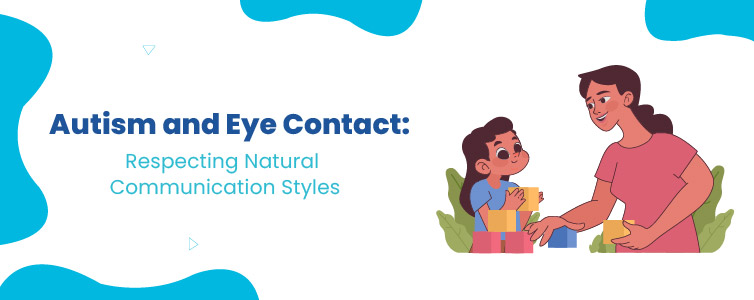For most individuals, eye contact is an important aspect of communication because it shows connection, interest, and attention. Making eye contact, however, is not always comfortable or natural for individuals with autism. In fact, it can be distracting, uncomfortable, or overwhelming.
Instead of forcing eye contact, it’s important to recognize and respect different communication styles. Understanding these differences helps create a more inclusive world where autistic people feel accepted.
This article explains why eye contact can be hard for autistic individuals and why forcing it is not helpful. Instead, we should respect different ways of communicating. Understanding this can help create a more inclusive world where autistic people feel accepted.
For many autistic people, eye contact doesn’t come easily. Some describe it as:
Research supports this experience. A 2017 study found that autistic people often avoid eye contact because their brains process social information differently. Forcing eye contact can actually make communication more difficult, not easier.
Many autistic individuals listen and engage best when they’re not expected to maintain eye contact. They might:
This doesn’t mean they’re ignoring the speaker they’re simply communicating in a way that works best for them.
Even outside of autism, eye contact has different meanings across cultures. For example:
This shows that eye contact isn’t the only or best way to show respect or attention.
Instead of insisting on eye contact, we should focus on understanding and accommodating different communication styles. This small change can make a big difference in making autistic people feel respected and included.

In Indian culture, making eye contact is seen as a sign of respect, attention, or good manners. Because of this, autistic children are often encouraged or even pressured to look people in the eye when speaking or listening. But for many autistic individuals, making eye contact can feel deeply uncomfortable or distracting. Insisting on it can cause more harm than good. Here’s why:
Some people with autism may find it difficult to make eye contact. They may become stressed and lose attention on the conversation when they are told to "look at me when I'm talking." Instead of processing what’s being said, they may become preoccupied with how long to hold eye contact or whether they’re doing it “correctly.” This can make communication harder, not easier.
Some autistic people learn to force eye contact to meet others’ expectations, even though it doesn’t feel natural to them. This effort to appear “normal” is called masking.
Over time, masking can be exhausting and may lead to burnout a state of extreme mental and emotional fatigue caused by the constant effort to hide one’s true feelings or needs.
When people interpret a lack of eye contact as rudeness, disinterest, or defiance, they may miss the real ways that autistic individuals express connection and engagement.
Many autistic people communicate effectively through other cues like body language, tone of voice, or thoughtful responses. Misreading their intentions can lead to unfair judgments and damage self-esteem.
For many autistic individuals, making eye contact can feel uncomfortable, distracting, or even distressing.
Instead of insisting on eye contact, we can support more inclusive and meaningful communication by recognizing and respecting different ways of connecting.
Eye contact is just one way to show attention but it’s not the only one. Many autistic people express engagement in other valid ways:
If you're unsure how someone prefers to communicate, it’s okay to ask. Questions like:
These questions show respect and a willingness to understand individual preferences. It helps build trust and supports more natural communication.
Whether you're a parent, teacher, or colleague, it's important to create environments where all communication styles are valued. That includes:
By making these small shifts, we support not only more effective communication but also greater acceptance and emotional safety for autistic individuals.
Eye contact is often seen as a sign of respect or attentiveness but it’s not the only way people connect.
For many autistic individuals, avoiding eye contact isn’t a sign of disinterest; it’s a natural and necessary way to stay regulated, focused, and comfortable.
Instead of expecting autistic people to fit into rigid social expectations, we can create more supportive environments by:
The goal isn’t to force conformity, it's to foster understanding. When we listen with openness and respond with respect, we make space for everyone to communicate in ways that are true to who they are. That’s how we build a more inclusive and compassionate world.